Workload Management: 10 Smart Ways to Keep Your Team Burnout-Free
Discover how effective workload management can boost team productivity and prevent burnout with these 10 practical strategies.
Workload management is the cornerstone of a productive, engaged, and healthy team. When workloads are balanced, teams thrive, projects stay on track, and burnout becomes a distant concern. Poor workload management, on the other hand, can lead to stress, missed deadlines, and disengaged employees.
In this comprehensive guide, we’ll explore 10 practical strategies to master workload management, leveraging tools like resource planning software and resource management techniques to ensure your team remains motivated and burnout-free.
Why Workload Management Matters
Effective workload management goes beyond checking tasks off a list. It’s about ensuring that every team member has a manageable amount of work that aligns with their skills and capacity. When workloads are poorly managed, the consequences can be severe:
- Burnout: Overloaded employees experience stress, fatigue, and disengagement, which can lead to high turnover.
- Missed Deadlines: Unbalanced workloads cause delays, impacting project timelines and client satisfaction.
- Low Morale: Teams that feel overwhelmed or underutilized lose motivation, affecting collaboration and creativity.
By prioritizing workload management, you create a sustainable work environment where employees feel valued and empowered. Tools like resource planning software and resource management systems can make this process more efficient, helping you track capacity, allocate tasks, and monitor progress in real time.
Let’s dive into the 10 smart strategies to keep your team burnout-free through effective workload management.
1. Assess Team Capacity Regularly
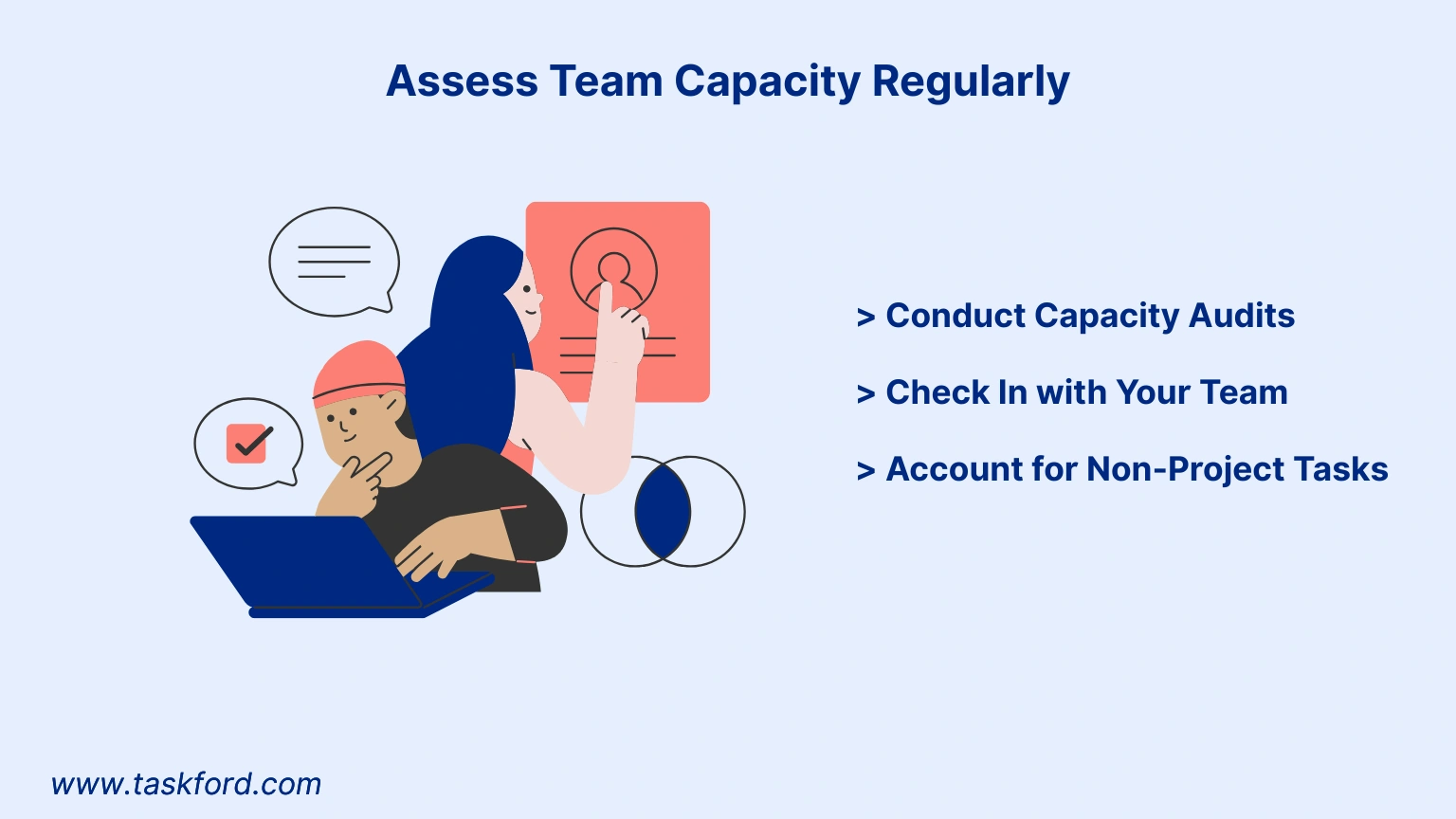
Understanding your team’s capacity is the foundation of workload management. Capacity refers to the amount of work your team can handle within a given timeframe without compromising quality or well-being.
How to Do It:
- Conduct Capacity Audits: Use resource planning software to track hours worked, tasks assigned, and upcoming deadlines. Tools like TaskFord, Asana, ClickUp provide detailed insights into team availability and workload distribution.
- Check In with Your Team: Regular one-on-one meetings can reveal if someone is overwhelmed or underutilized. Ask questions like, “Do you feel your current workload is manageable?”
- Account for Non-Project Tasks: Don’t forget administrative duties, meetings, or unexpected tasks when calculating capacity.
By regularly assessing capacity, you can distribute tasks more effectively and prevent overloading your team.
2. Prioritize Tasks Based on Impact
Not all tasks are created equal. Prioritizing high-impact tasks ensures your team focuses on what drives the most value for your projects or business.
How to Do It:
- Use a Prioritization Framework: Frameworks like Eisenhower Matrix or MoSCoW (Must-have, Should-have, Could-have, Won’t-have) help categorize tasks by urgency and importance.
- Align with Goals: Ensure tasks align with project objectives or company goals to avoid wasting time on low-value work.
- Leverage Resource Management Tools: Resource planning software can help you visualize task priorities and assign them to the right team members based on skills and availability.
Prioritizing tasks keeps your team focused and reduces the stress of juggling competing demands.
(Learn more: How to Prioritize Tasks When There’s Too Much To Do)
3. Use Resource Planning Software for Visibility
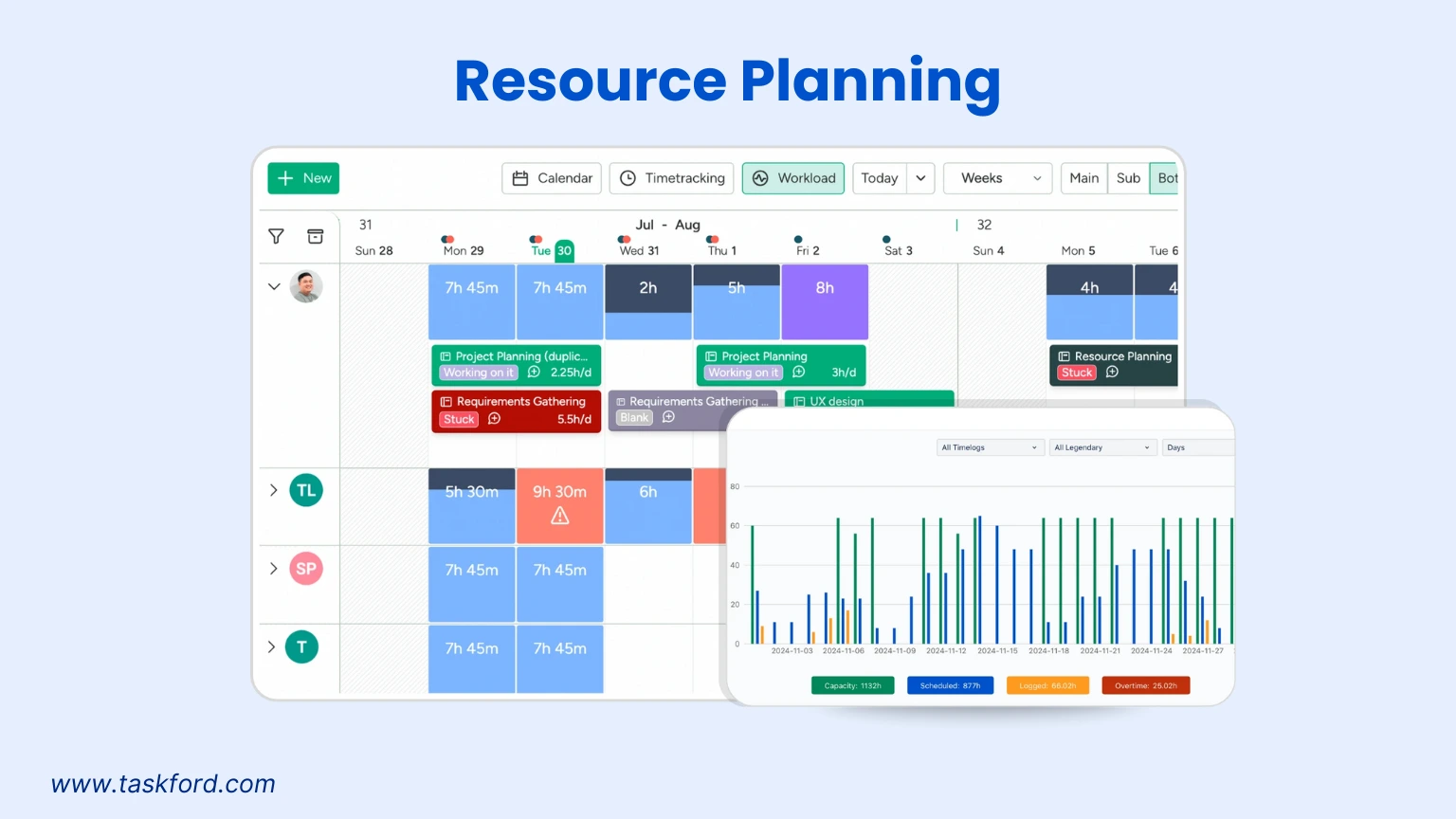
Resource planning software is a game-changer for workload management. These tools provide a clear view of who’s working on what, how much time they have, and where bottlenecks might occur.
Benefits of Resource Planning Software:
- Real-Time Tracking: Monitor task progress and team capacity in real time.
- Data-Driven Decisions: Use analytics to identify overworked team members or underutilized resources.
- Improved Collaboration: Share schedules and task assignments to keep everyone on the same page.
TaskFord’s resource planning features, for example, allow you to allocate tasks based on availability, skill sets, and project deadlines, ensuring no one is stretched too thin.
4. Match Tasks to Skills and Strengths
Assigning tasks based on team members’ skills and strengths not only improves efficiency but also boosts morale. When employees work on tasks they’re good at, they feel more confident and engaged.
How to Do It:
- Map Skills to Tasks: Create a skills inventory for your team and use it to assign tasks that match their expertise.
- Encourage Growth: Occasionally assign stretch tasks to help team members develop new skills, but balance these with familiar tasks to avoid overwhelm.
- Use Resource Management Systems: Tools like TaskFord can store employee profiles, including skills and experience, making it easier to assign tasks effectively.
Matching tasks to skills ensures high-quality output and keeps your team motivated.
5. Set Realistic Deadlines
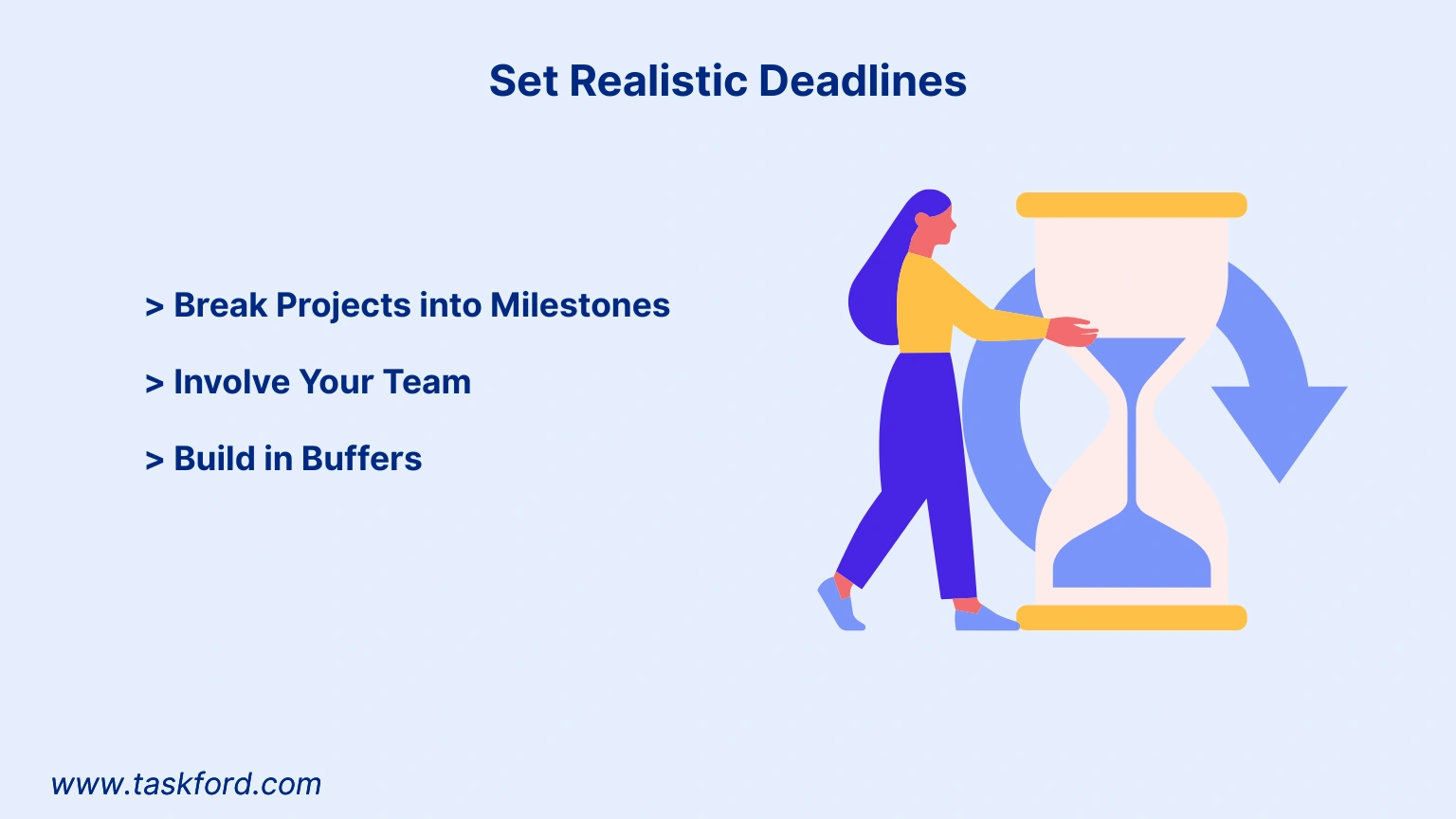
Unrealistic deadlines are a major cause of burnout. Setting achievable timelines gives your team the space to produce quality work without unnecessary pressure.
How to Do It:
- Break Projects into Milestones: Divide large projects into smaller, manageable tasks with clear deadlines.
- Involve Your Team: Consult team members when setting deadlines to ensure they’re realistic based on their workload and expertise.
- Build in Buffers: Account for unexpected delays by adding buffer time to your schedules.
A resource planning tool can help you visualize project timelines and adjust deadlines based on team capacity.
6. Encourage Open Communication
A culture of open communication is essential for effective workload management. Team members should feel comfortable discussing their workload, challenges, or concerns without fear of judgment.
How to Foster Communication:
- Hold Regular Check-Ins: Weekly or biweekly meetings allow team members to share updates and flag issues.
- Give Anonymous Feedback: If employees hesitate to speak up, anonymous surveys can help uncover workload-related concerns.
- Be Approachable: Create an environment where team members feel safe discussing their capacity or asking for help.
Open communication helps you identify workload imbalances early and address them before they lead to burnout.
7. Delegate Effectively
Delegation is a critical skill for workload management. Effective delegation ensures tasks are distributed evenly and empowers team members to take ownership of their work.
Tips for Effective Delegation:
- Know Your Team: Understand each member’s strengths, weaknesses, and current workload before delegating.
- Provide Clear Instructions: Clearly outline expectations, deadlines, and deliverables for each task.
- Trust Your Team: Avoid micromanaging. Give team members the autonomy to complete tasks in their own way.
8. Monitor and Adjust Workloads in Real Time
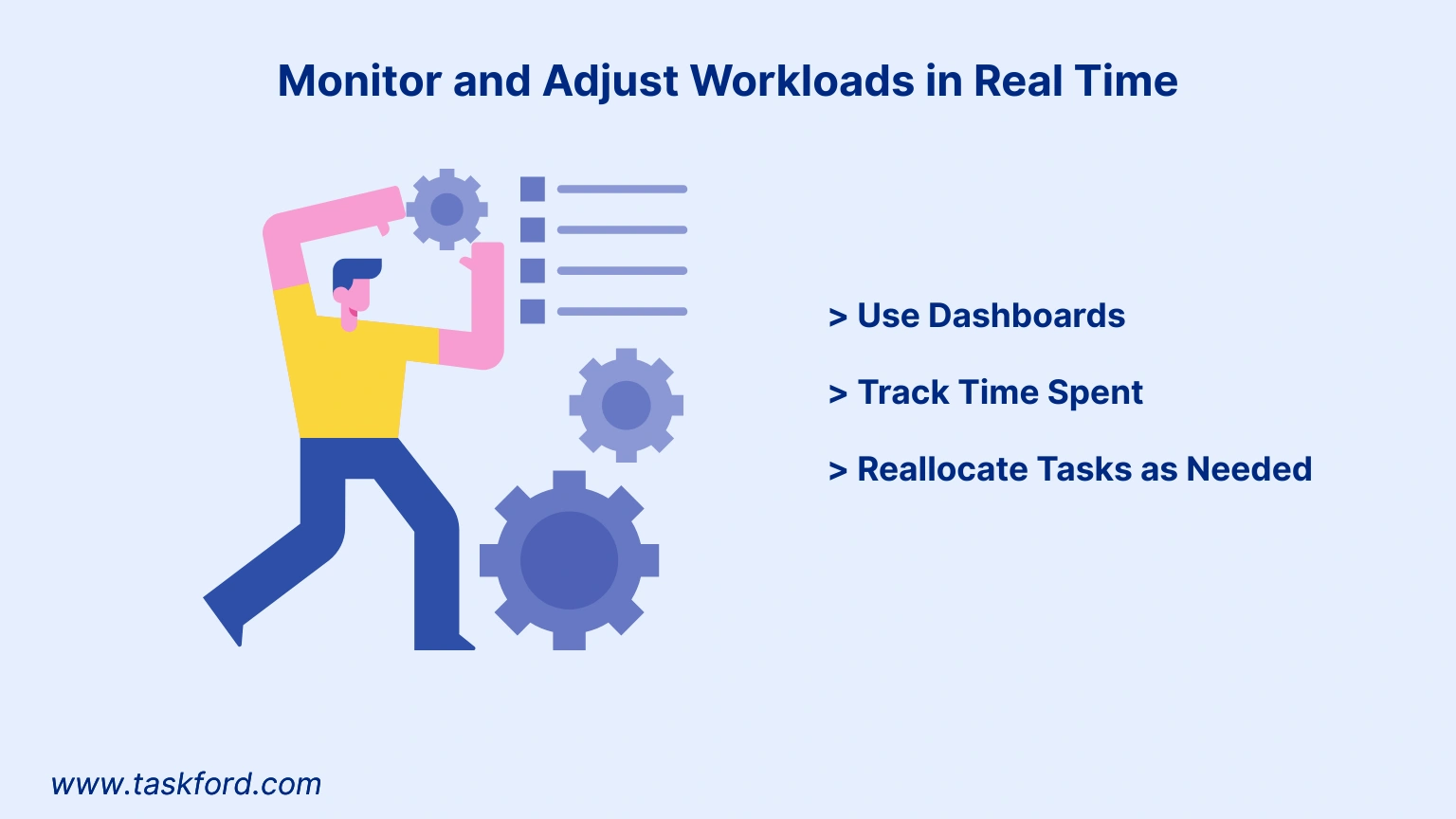
Workloads can shift as projects evolve, so it’s important to monitor and adjust them regularly. Real-time adjustments prevent bottlenecks and keep your team balanced.
How to Monitor Workloads:
- Use Dashboards: A comprehensive project management and resource planning platform like TaskFord offers dashboards that display workload distribution across your team.
- Track Time Spent: Monitor how much time team members spend on tasks to identify inefficiencies or overworked individuals.
- Reallocate Tasks as Needed: If someone is overwhelmed, redistribute tasks to team members with more capacity.
By staying proactive, you can address workload imbalances before they escalate.
9. Promote Work-Life Balance
A healthy work-life balance is essential for preventing burnout. When employees feel supported in balancing their professional and personal lives, they’re more productive and engaged.
How to Promote Work-Life Balance:
- Set Boundaries: Encourage team members to disconnect after work hours and avoid sending emails or messages late at night.
- Offer Flexibility: Allow flexible work hours or remote work options when possible to accommodate personal needs.
- Provide Wellness Resources: Offer access to mental health resources, wellness programs, or time off to recharge.
A team with a healthy work-life balance is less likely to experience burnout and more likely to stay productive.
10. Review and Learn from Past Projects
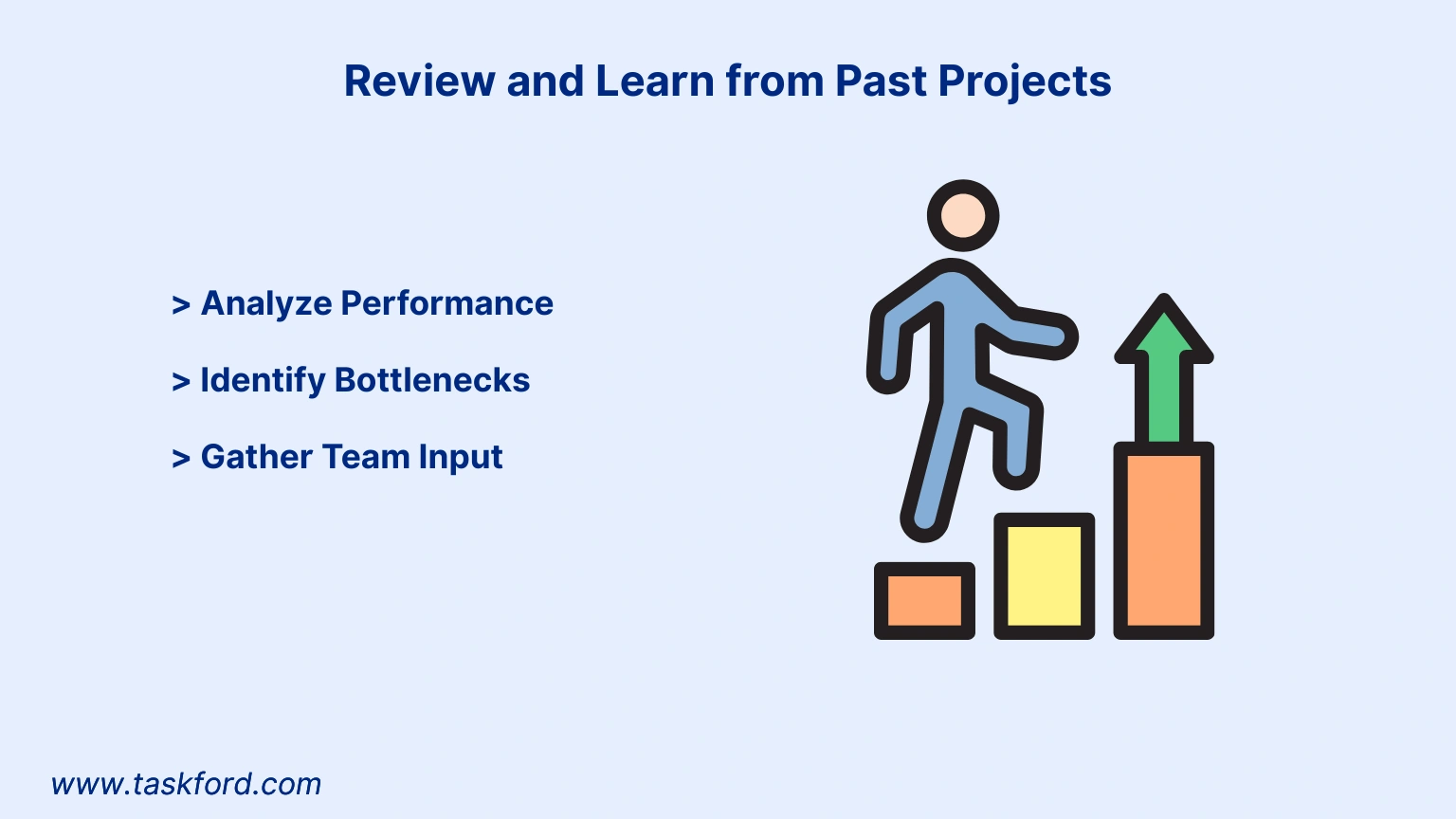
Continuous improvement is key to mastering workload management. Reviewing past projects helps you identify what worked, what didn’t, and how to improve for the future.
How to Conduct a Review:
- Analyze Performance: Review task completion rates, time spent, and team feedback.
- Identify Bottlenecks: Look for patterns, such as recurring delays or overworked team members, and address them in future planning.
- Gather Team Input: Ask your team what helped or hindered their ability to manage their workload.
By learning from past projects, you can refine your workload management strategies and create a more efficient process.
The Role of Resource Management in Workload Success
Resource management is the backbone of effective workload management. It involves allocating people, time, and tools in a way that maximizes productivity while minimizing stress. Here’s how resource management ties into workload success:
- Optimizes Task Allocation: Ensures tasks are assigned based on skills and availability.
- Prevents Overload: Helps you spot overworked team members before burnout sets in.
- Improves Project Outcomes: Balanced workloads lead to higher-quality work and timely delivery.
To learn more about about resource management, read our guide on Explaining Resource Management
Common Workload Management Challenges and How to Overcome Them
Even with the best intentions, workload management can face challenges. Here are some common issues and how to address them:
- Uneven Work Distribution: Use resource planning software to monitor workloads and reassign tasks as needed.
- Unexpected Tasks: Build buffer time into schedules to accommodate unforeseen work.
- Resistance to Change: Communicate the benefits of workload management tools and involve your team in the implementation process.
By anticipating these challenges, you can proactively address them and keep your team on track.
Conclusion: Building a Burnout-Free Team with Workload Management
Workload management is more than just assigning tasks. It’s about creating a sustainable, productive, and positive work environment where your team can thrive. By assessing capacity, prioritizing tasks, using resource planning software, and fostering open communication, you can prevent burnout and keep your team engaged.
Implementing these 10 strategies will help you master workload management and create a culture of balance and productivity. Resource planning tools like TaskFord can make the process easier, providing the visibility and control you need to succeed.
Ready to take your workload management to the next level? Start by evaluating your team’s current workload, investing in resource planning software, and putting these strategies into action. Your team and your projects will thank you.
Learn more
- How To Reduce Burnout On A Project Before It Affects Your Team
- 8 Resource Optimization Techniques Your Team Will Thank You For
- Top 10 Employee Engagement Strategies That Actually Work in 2025
Subscribe for Expert Tips
Unlock expert insights and stay ahead with TaskFord. Sign up now to receive valuable tips, strategies, and updates directly in your inbox.